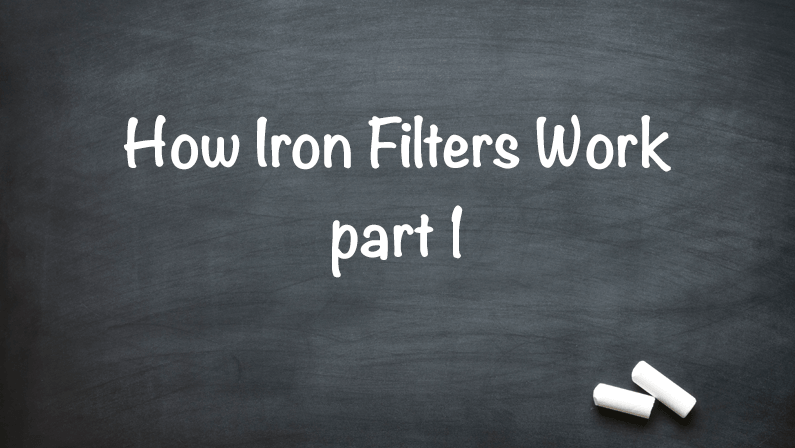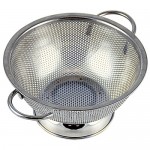How Iron Filters Work – Part One

Iron Filters are easily the most misunderstood solution in the water treatment industry – in fact many water softener salespeople even get confused!
While there are many important design considerations, the basic principles of iron filtration are simple.
This is the first article in a 3 part series that will help you understand how an iron filter works, and to avoid wasting your time and money on the wrong iron filter (which probably never had a chance of working in the first place).
Iron Filters Use a 3 Step Process
Air Injected Iron Filters, Chlorine Injected Iron Filters, Greensand Filters, and Pyrolox Filters all follow a 3 Step Process:
Step 1: Pre-Treatment aka “Oxidation”
Pre-Treatment involves using an oxidant to cause contaminants in the water to precipitate and settle out. Precipitated contaminants are much larger and clump together so they can be removed through straining.
Air, chlorine, ozone, and hydrogen peroxide are common oxidants that are injected into the water during pre-treatment.
The chemical coating on Greensand, Birm, and Pyrolox have limited oxidizing capabilities on their own, but they can all be made more effective with the addition of a stronger oxidant (air, chlorine, etc.).
**If contaminants like iron are not fully oxidized, they CANNOT be removed with filtration**
Step 2: Filtration
Imagine you’re cooking dinner. You’ve just finished boiling some raviolis on the stove, and it’s time to drain out the water.
If you slowly pour the raviolis into a colander, they will strain out nicely, and the water will go down the drain.

Now imagine a different approach: What if those ravioli were propelled at a high velocity towards said colander. What would happen? Well, some raviolis would manage to be strained out, but the rest would disintegrate and blow right through!
Filtration works EXACTLY the same way.
If water flows through an Iron Filter slowly enough, it will mechanically strain crud like iron, manganese, hydrogen sulfide, and arsenic out of your water. Run water too fast – you get the picture.
Step 3: Backwash – The Final Step
Once a filter is caked full of the sludge it removed from your water, it needs to completely clean itself out.
A backwash is a forceful flush that removes this sludge.
If a filter can’t get clean, it will load up with crud and begin solidifying into a massive chunk that can weigh 100’s to 1,000’s of pounds. Needless to say, it will stop functioning.
Can You Kill Three Birds with One Stone?
Sometimes both the oxidation and filtration steps can be accomplished in a single tank iron filter (along with backwash of course). While these iron filters can work, systems that use a dedicated tank for both Pre-Treatment and Filtration are far more effective. Two tank Iron Filters allow more fine-tuning, and never short change either of those critical steps.
Iron Filters Should Be Based on Your Needs
You now have a basic understanding of how an iron filter works. Now you should think about how much water you actually need to filter. This figure is called “Flow Rate” and is measured in “gallons per minute” or gpm.
Understanding your flow rate requirements is a critical step to correctly designing the size and configuration of a filter system.
We previously covered what flow rates are and how to calculate your needs in an article called “Flow Rates-the Achilles Heel of Any Water System”.
What’s Next?
In Part Two of this series we’ll go into more detail about Pre-Treatment, Filtration and Backwash. Part Three will put it all together and show how we build a whole house iron filter as well as a larger irrigation system.
Who We Are
Premier Water is a local, family-owned water treatment company based in Chanhassen, MN. Since 1978, Premier Water has successfully implemented 1000’s of Residential and Commercial Iron Filters to treat a variety of well water conditions. We offer a FREE WATER TEST to gather information and help our clients with the right solution for their needs. We can also be reached at (952) 479-4553 for more information.

I like the info i found on your website. I am pretty sure i have a Iron bacteria. Its more common here than not. We have the oil slick kind. Ironically i have found when you boil water, it goes away…or heat it at least. It shows up in cold water, but not on the hotwater side of our house. I was actaully looking for a filter i could put on my gardenhose for watering our veggie garden. But i guess its not that simple. i would like to get a water test kit though just to make sure.
Not sure about boiling water killing Iron Bacteria, but it could work…
Most water heaters are not hot enough, and Iron Bacteria will often colonize there.
Where are you located? We offer local service in the Twin Cities.
Thanks for posting!
I have attended classes that said that the odor in “sulphur water” is a bacteria and the water heater kills it. Is this true ? It was the tech guy at the wholesaler supply house that told us that. Is iron bacteria the same ?
You would need very high heat to kill the bacteria.
We see a lot of homes where the hot water smells worse than the cold water due to bacteria growth in the water heater. Thanks for posting!